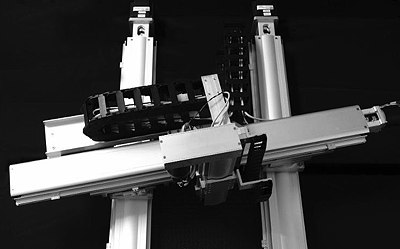Intellidrives says that the gantry design covers a larger working area than delta robots, which are also more expensive and bulky.
In traditional X-Y gantry designs, the upper gantry member (Y-axis) is carried by two identical lower axes (X1 and X2) with motor/screw/bearing systems separated by distance orthogonal to the direction of the axes.
Imprecision in the components – such as linear guide deflections, ballscrew lead errors, and misaligned axes – affects the variation of the position errors in the X1 and X2 axes, and the orthogonality of the X-Y gantries. As a Y-axis carrying a load traverses the X-Y plane, it also introduces X-axis position errors that depend on the Y-axis position.
The current way of tackling this challenge is either to implement 2D position error-mapping, or to suspend the Y-axis on flexible members and to control the X1 and X2 axes independently to ensure orthogonality. But this reduces system bandwidth and provides a small range of angle adjustment – usually not more than 1 degree.
There are also many applications where a large theta angle is an intentional feature of the design to align the work tool with non-orthogonally located objects, or to align patterns.

Intellidrives’ X-Y gantry allows one of the axes to rotate through an angle of 20 degrees or more.
Intellidrives’ new X-Y gantry, where the theta angle can exceed 20 degrees, contains two pivot points on X1 and X2 axes that allow the Y cross-axis to rotate around each X-axis and be displaced linearly about each of them.
The current system uses motorised ballscrew actuators with brushless servomotors/encoders, but it could also be implemented using direct-drive linear servomotors. Optional Z-axes could also be added.
A dual-axis controller controls the X1 and X2 positions and theta (X1-X2) independently. This allows the axes to be displaced by any programmable distance and, in turn, allows Y-axis rotation around any programmable pivot point.
The system has been designed for an X-Y travel of 800 x 800mm, with 20 degrees of Y-axis rotation. It can operate at X-Y speeds of up to 300mm/s and resolutions of 2.5µm. The theta angle control achieves a resolution of 1 arc-sec with a repeatability of 3 arc-sec. Intellidrives says that the design could be adapted to larger X-Y travels and theta adjustments.
The gantry has already been used successfully to manufacture semiconductor wafers and flat-panel displays.

